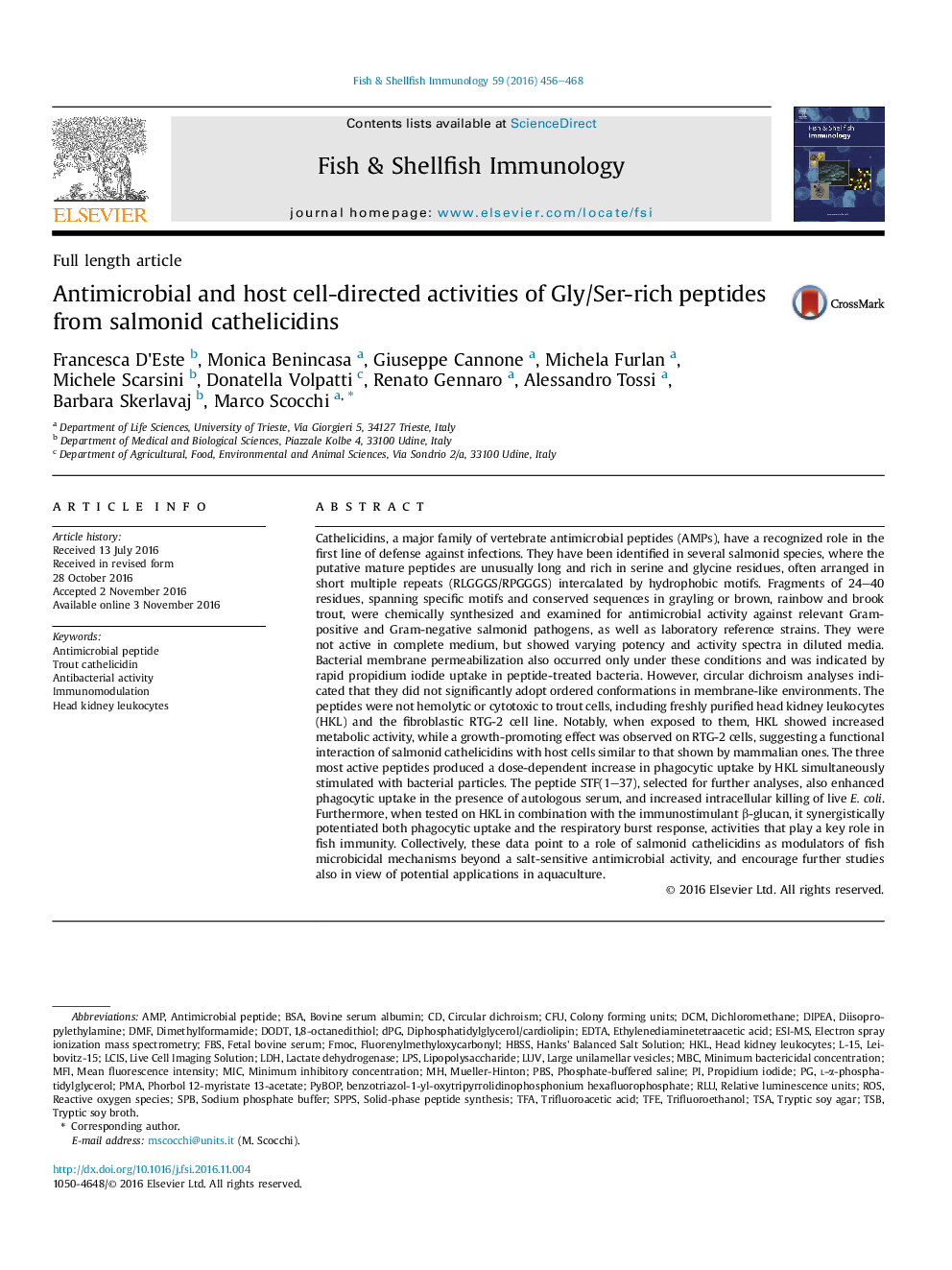| کد مقاله | کد نشریه | سال انتشار | مقاله انگلیسی | نسخه تمام متن |
|---|---|---|---|---|
| 5540810 | 1553615 | 2016 | 13 صفحه PDF | دانلود رایگان |
عنوان انگلیسی مقاله ISI
Antimicrobial and host cell-directed activities of Gly/Ser-rich peptides from salmonid cathelicidins
دانلود مقاله + سفارش ترجمه
دانلود مقاله ISI انگلیسی
رایگان برای ایرانیان
کلمات کلیدی
LCISDCMESI-MSMICMBCHBSSDPGSPBphorbol 12-myristate 13-acetateTSBTFAFMOCRLUTFEtrifluoroethanolFluorenylmethyloxycarbonylSPPSPyBOPbenzotriazol-1-yl-oxytripyrrolidinophosphonium hexafluorophosphateHKLFBSDMFPBSCFULPSMFITSAAMPBSA - BSAPMA - LDC هاROS - ROSTryptic Soy Agar - Tryptic من آگار هستمbovine serum albumin - آلبومین سرم گاوEDTA - اتیلن دی آمین تترا استیک اسید Ethylenediaminetetraacetic acid - اتیلینیدامین تتراستیک اسیدTrifluoroacetic acid - اسید Trifluoroaceticsodium phosphate buffer - بافر فسفات سدیمlarge unilamellar vesicles - بزرگ کیسه های بدون انعطاف پذیرImmunomodulation - تنظیم ایمنی minimum bactericidal concentration - حداقل غلظت باکتریMinimum inhibitory concentration - حداقل غلظت مهاریdiisopropylethylamine - دی ایزوپروپیلایتیلامینdimethylformamide - دی متیل فرمالیدDichloromethane - دیکلورمتانcircular dichroism - رنگ تابی دورانیHead kidney leukocytes - سرطان کلیهfetal bovine serum - سرم جنین گاوSolid-phase peptide synthesis - سنتز پپتید جامد فازTryptic soy broth - سوپ سویا TrypticAntibacterial activity - فعالیت ضد باکتریlactate dehydrogenase - لاکتات دهیدروژناز LDH - لاکتات دهیدروژناز به صورت مختصر شده LDH LUV - لووlipopolysaccharide - لیپوپلی ساکاریدPhosphate-buffered saline - محلول نمک فسفات با خاصیت بافریHanks' balanced salt solution - محلول نمک متعادل هانکسMueller-Hinton - مولر-هینتونmean fluorescence intensity - میانگین شدت فلورسانسDIPEA - نخودrelative luminescence units - واحد لومینسانس نسبیcolony forming units - واحدهای تشکیل دهنده کلنیPropidium iodide - پروتئین یدیدAntimicrobial peptide - پپتیدهای ضدمیکروبیReactive oxygen species - گونههای فعال اکسیژن
موضوعات مرتبط
علوم زیستی و بیوفناوری
علوم کشاورزی و بیولوژیک
علوم آبزیان
پیش نمایش صفحه اول مقاله

چکیده انگلیسی
Cathelicidins, a major family of vertebrate antimicrobial peptides (AMPs), have a recognized role in the first line of defense against infections. They have been identified in several salmonid species, where the putative mature peptides are unusually long and rich in serine and glycine residues, often arranged in short multiple repeats (RLGGGS/RPGGGS) intercalated by hydrophobic motifs. Fragments of 24-40 residues, spanning specific motifs and conserved sequences in grayling or brown, rainbow and brook trout, were chemically synthesized and examined for antimicrobial activity against relevant Gram-positive and Gram-negative salmonid pathogens, as well as laboratory reference strains. They were not active in complete medium, but showed varying potency and activity spectra in diluted media. Bacterial membrane permeabilization also occurred only under these conditions and was indicated by rapid propidium iodide uptake in peptide-treated bacteria. However, circular dichroism analyses indicated that they did not significantly adopt ordered conformations in membrane-like environments. The peptides were not hemolytic or cytotoxic to trout cells, including freshly purified head kidney leukocytes (HKL) and the fibroblastic RTG-2 cell line. Notably, when exposed to them, HKL showed increased metabolic activity, while a growth-promoting effect was observed on RTG-2 cells, suggesting a functional interaction of salmonid cathelicidins with host cells similar to that shown by mammalian ones. The three most active peptides produced a dose-dependent increase in phagocytic uptake by HKL simultaneously stimulated with bacterial particles. The peptide STF(1-37), selected for further analyses, also enhanced phagocytic uptake in the presence of autologous serum, and increased intracellular killing of live E. coli. Furthermore, when tested on HKL in combination with the immunostimulant β-glucan, it synergistically potentiated both phagocytic uptake and the respiratory burst response, activities that play a key role in fish immunity. Collectively, these data point to a role of salmonid cathelicidins as modulators of fish microbicidal mechanisms beyond a salt-sensitive antimicrobial activity, and encourage further studies also in view of potential applications in aquaculture.
ناشر
Database: Elsevier - ScienceDirect (ساینس دایرکت)
Journal: Fish & Shellfish Immunology - Volume 59, December 2016, Pages 456-468
Journal: Fish & Shellfish Immunology - Volume 59, December 2016, Pages 456-468
نویسندگان
Francesca D'Este, Monica Benincasa, Giuseppe Cannone, Michela Furlan, Michele Scarsini, Donatella Volpatti, Renato Gennaro, Alessandro Tossi, Barbara Skerlavaj, Marco Scocchi,